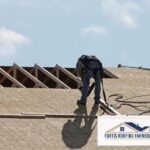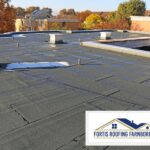Are you planning to build or renovate a house in the UK in 2023? Are you wondering what the standard roof pitch you should consider is? Look no further!
This article will provide you with all the information you need to know about the standard roof pitch in the UK. We will cover the basics, design considerations, and factors that influence the pitch. We will guide you through the common options and help you choose the perfect roof pitch for your project.
Let’s get started!
The Basics of Roof Pitch
You should understand the basics of roof pitch before starting any roofing project.
Roof pitch refers to the steepness or slope of a roof. It’s typically expressed as a ratio of the vertical rise to the horizontal run.
Understanding roof pitch is crucial because it affects several aspects of your roofing project, including the type of roofing material you can use and the overall design and functionality of your roof.
A steeper roof pitch allows for better drainage and is suitable for areas with heavy rainfall or snowfall. On the other hand, a lower roof pitch is more common in areas with mild weather conditions.
Additionally, knowing the roof pitch is essential when estimating the amount of materials needed and ensuring proper installation.
Therefore, take the time to measure and understand your roof pitch before embarking on any roofing project.
How Roof Pitch Affects Design
Understanding roof pitch and its effects on design is crucial when planning your roofing project.
The roof pitch, or slope, not only determines the aesthetic appeal of your home but also plays a significant role in its functionality.
A steeper roof pitch allows for better drainage, reducing the risk of water leaks and potential damage. It also provides more space in the attic, enabling better ventilation and insulation.
On the other hand, a lower roof pitch offers a more modern and sleek look. However, it may require additional measures to ensure proper drainage and insulation.
When considering the design of your roof, it’s essential to take into account the climate, architectural style, and personal preferences to achieve the perfect balance between form and function.
Factors that influence the standard roof pitch in the UK
There are several factors that can influence the standard roof pitch in the UK.
Local building codes and regulations play a crucial role in determining the standard roof pitch. These codes ensure that the roof is structurally sound and able to withstand the specific weather conditions in the region.
Climate conditions affect the roof pitch as well. Areas with heavy rainfall or snowfall may require a steeper pitch to prevent water or snow buildup. On the other hand, regions with mild climates may have a lower standard roof pitch.
Lastly, architectural styles also influence the standard roof pitch. Certain architectural designs may call for a specific roof pitch to maintain the aesthetic appeal of the building.
Common Roof Pitch Options in the UK
When it comes to selecting the right roof pitch for your home in the UK, there are several options to consider. Here are some of the most common choices:
Low pitch (2-5 degrees): This option is suitable for flat or nearly flat roofs, commonly found in modern architecture.
Medium pitch (10-20 degrees): This option provides a good balance between aesthetics and functionality, making it a popular choice for residential properties.
Steep pitch (30-45 degrees): This option is often seen in traditional or period-style homes, adding visual interest and allowing for better water runoff.
Very steep pitch (above 45 degrees): This option is ideal for areas with heavy snowfall or where durability and longevity are essential.
Custom pitch: In some cases, a custom roof pitch may be required to accommodate specific architectural designs or constraints.
Choosing the right roof pitch is crucial for ensuring the structural integrity and overall look of your home. Consider consulting with a professional roofer or architect to determine the best option for your specific needs.
Choosing the Right Roof Pitch for Your Project
To choose the right roof pitch for your project, you should consider the specific requirements and constraints of your construction. The roof pitch plays a crucial role in determining the overall aesthetics, functionality, and durability of your roof. It affects the drainage, snow load capacity, and even the energy efficiency of your building.
In general, steeper pitches are better for areas with heavy rainfall or snowfall, as they facilitate water and snow runoff. However, they may require additional structural support and maintenance.
On the other hand, lower pitches are more suitable for areas with mild climates. They’re easier to install and maintain but may not be as effective in areas with heavy precipitation.
Ultimately, choosing the right roof pitch involves balancing both functional and aesthetic considerations, ensuring that it meets your specific needs and complements the overall design of your project.
Frequently Asked Questions
What are the average costs associated with different roof pitch options in the UK?
The average costs associated with different roof pitch options in the UK can vary depending on various factors. Factors such as the size of the roof, the materials used, and the complexity of the design can all affect the total cost.
Location and market demand can also affect costs.
It is recommended to consult with a professional roofing contractor who can provide a customized estimate based on individual needs and requirements.
Can I alter the angle of the roof on my current house without undergoing extensive renovations?
Changing the roof pitch of your existing house can be a challenging task that requires careful consideration. It involves altering the structural design and may necessitate the assistance of professionals.
Visualise this process as a delicate transformation where the slope of your roof is modified to meet your desired pitch. This alteration can have an impact on both the overall look and functionality of your home, making it crucial to consult with experts who can guide you through the process smoothly.
How does the roof pitch affect the durability and lifespan of the roof?
The pitch of your roof has a significant impact on its durability and lifespan.
A steeper pitch allows for easy water and debris runoff, preventing any water damage and reducing the chances of leaks. It also provides better structural support by evenly distributing weight due to the angle.
Furthermore, a higher pitch promotes better ventilation, minimizing the risk of moisture buildup, mold, or rot.
Are there any specific roofing materials that are recommended for certain roof pitch options in the UK?
When it comes to specific roofing materials recommended for certain roof pitch options in the UK, there are a few factors to consider.
The pitch of your roof affects the type of materials that can be used effectively. For low-pitched roofs, materials like asphalt shingles or rubber roofing may be more suitable.
Steeper roofs can accommodate a wider range of materials, such as slate or clay tiles.
It’s important to consult with a professional to determine the best materials for your specific roof pitch.
Thanks for reading our post, feel free to check out our other services:











